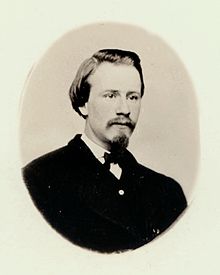John O'Fallon
 | |
| Born | 1791 |
|---|---|
| Died | December 17, 1865 |
| Allegiance | |
| Service/ | |
| Years of service | 1812—1818 |
| Rank | Captain |
| Unit | 2nd Regiment of Riflemen Regiment of Riflemen |
John O'Fallon (1791 – December 17, 1865) was a businessman, philanthropist, and military officer, a nephew of the explorer William Clark. During the 19th century he rose to become the wealthiest person in St. Louis, Missouri.[1] The cities of O'Fallon, Illinois and O'Fallon, Missouri are named after him.[2]
In 1857, he donated over $1 million to establish the O'Fallon Institute at what is now Washington University in St. Louis.[3] O'Fallon's father, James O'Fallon, was a physician who served as a surgeon in Washington's army during the Revolutionary War. After the war, he went to Louisville, Kentucky, married Frances Clark, a sister of George Rogers Clark and William Clark, Army officers, who became famous in exploring the Mississippi Valley.
In 1793, when O'Fallon was two and his brother Benjamin was an infant, his father died. According to one source, the boys were sent to St. Louis and raised by their mother's brother, William Clark.[4] Another source says he was raised by his mother. Given the ages of John and Benjamin at the time, it seems possible that when their father died, William Clark offered his sister and her two infant children a permanent home with him in St. Louis.
In 1810, John graduated from college in Lexington, Kentucky.[5]
Following in his father's footsteps, and at the urging of his friends and, probably, of a close family friend, Major Croghan, he entered the army early in the War of 1812. He was assigned to General Harrison's army at Vincennes, Indiana. Promoted to Captain of the Second U.S. Rifle Regiment by March 1814, by May 1815 he commanded this unit.[6]
When the war ended, Congress downsized the army. O'Fallon was one of only four captains it chose to retain. However, on 31 July 1818, he resigned his commission, returned to St. Louis, and secured a post as sutler to the Yellowstone Expedition.[7] The sluggish expedition never reached its destination. When it took two years to even reach Fort Lisa (near present-day Council Bluffs, Iowa), Congress cut its funding.[8] O'Fallon continued as an army sutler in the Council Bluffs area. He freighted his supplies up the Mississippi river in his own boat or boats.[9] In 1820, one of them sank, fully loaded, and nearly wiped him out. St. Louis financial institutions had been hard-hit by the Panic of 1819 and credit was tight, further adding to his financial woes. O'Fallon eventually decided that for him, the risks weren't worth the potential profit.
In 1823, he turned his sutler's business over to a close friend (James Kennerly) and began farming and making whiskey with his half-brother in Louisville, Kentucky. The whiskey-making, apparently, turned a big profit.[10]
His whiskey trade apparently didn't hurt his reputation; in 1822 St. Louis elected him Representative to the first Missouri State Legislature, and re-elected him in 1824.[11]
Through subsequent investment, speculation, and inheritance he became one of the leading businessmen of St. Louis. He was president of a branch bank of the U.S. Bank, and "was on the board of half the businesses in St. Louis."[12]
He was especially active in railroad-building. O'Fallon presided over the 1849 committee which formed the Pacific Railroad (now Missouri Pacific Railroad); was the first president of the Ohio and Mississippi Railroad (now Baltimore and Ohio Railroad) and in 1850 became president of and the North Missouri Railroad (now the Wabash Railroad).[12]
In later life, O'Fallon seems to have used a significant amount of his wealth and prestige for the benefit others. He donated land for Saint Louis University, Washington University in St. Louis (two blocks), O'Fallon Park, and a water works. He also financially supported Washington University's medical college[12] and founded O'Fallon Polytechnic Institute.[13] A long-time slaveowner, O'Fallon was deeply committed to maintaining the peculiar institution, so much so that in 1846 he was elected president of an anti-abolitionist organization intended to "counteract the evil influence...of the abolitionists of the North.”[14]
O'Fallon died on December 17, 1865, in St. Louis. He was buried in Bellefontaine Cemetery.
References[]
- ^ "Archived copy". Archived from the original on 2009-12-01. Retrieved 2010-01-13.CS1 maint: archived copy as title (link)
- ^ Eaton, David Wolfe (1918). How Missouri Counties, Towns and Streams Were Named. The State Historical Society of Missouri. p. 356.
- ^ Edited Appletons Encyclopedia, Copyright © 2001
- ^ Delo, David M. Peddlers and Post Traders: The Army Suttler on the Frontier. Helena, MT: Kingfisher Books, 1998. p. 35; Delo cites Richard Edwards and M. Hopewell, M.D. Edward's Great West and Her Commercial Metropolis and a History of St. Louis (St. Louis: Edward's Monthly, 1860), 79-80
- ^ Delo, David M. Peddlers and Post Traders: The Army Suttler on the Frontier. Helena, MT: Kingfisher Books, 1998. p. 35
- ^ Delo, Peddlers and Post Traders, p. 36
- ^ Delo, Peddlers and Post Traders, pp. 36-37
- ^ Delo, Peddlers and Post Traders, p. 39
- ^ Delo, Peddlers and Post Traders, p. 37
- ^ Delo, Peddlers and Post Traders, pp. 40-42
- ^ "Missouri Government: Archives: History: Missouri State Legislators, 1820-2000", accessed 2/27/2017
- ^ Jump up to: a b c Marshall D. Hier, "Judge Luke Lawless’s Transcendent Charge to the Grand Jury," St. Louis Bar Journal, v. 64, no. 2, Fall 2017.
- ^ "Motor Racing Patron St. Louis Family Dies," St. Louis Post-Dispatch, 15 Jan 1941, p. 21
- ^ Heir, Marshall (2017). "Judge Luke Lawless's Transcendent Charge to the Grand Jury". St. Louis Bar Journal. 64: 38–41.
External links[]
- American philanthropists
- 1791 births
- 1865 deaths
- Washington University in St. Louis people
- Burials at Bellefontaine Cemetery